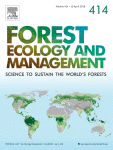Ver ítem
- xmlui.general.dspace_homeCentros Regionales y EEAsCentro Regional Buenos Aires NorteEEA Delta del ParanáArtículos científicosxmlui.ArtifactBrowser.ItemViewer.trail
- Inicio
- Centros Regionales y EEAs
- Centro Regional Buenos Aires Norte
- EEA Delta del Paraná
- Artículos científicos
- Ver ítem
Production ecology and reverse growth dominance in an old-growth ponderosa pine forest
Resumen
The growth of a stand is the sum of the growth of individual trees. Growth of individual trees can be explained by the amount of resources captured and how efficiently those resources are used (production ecology). The relationship between the contribution of a tree to stand growth relative to the contribution to stand biomass is expressed by the growth dominance. Patterns of growth dominance vary among tree species and stand age, suggesting that
[ver mas...]
The growth of a stand is the sum of the growth of individual trees. Growth of individual trees can be explained by the amount of resources captured and how efficiently those resources are used (production ecology). The relationship between the contribution of a tree to stand growth relative to the contribution to stand biomass is expressed by the growth dominance. Patterns of growth dominance vary among tree species and stand age, suggesting that differences in production ecology underlie the observed patterns of growth dominance within stands. We explored the production ecology in an old-growth ponderosa pine forest. Growth dominance was strongly negative (−0.22) and was the outcome of a less-than-proportional increase of tree growth as a function of tree size. Dominant trees were almost 5 times larger than suppressed trees (1024 vs. 211 kg tree−1) but grew only about 2 times more than suppressed trees (4.3 vs. 1.9 kg tree−1 year−1). Dominant trees captured a lessthan-proportional amount of light relative to their size (90.4 vs. 20.9 GJ year−1 tree−1) and light use efficiency declined with tree size. Suppressed trees were twice as efficient as dominant trees (0.11 vs. 0.05 kg[wood] GJ [PAR]−1). Our results highlight the link between growth dominance, competition for resources, and the pattern of light use efficiency among large versus small trees.
[Cerrar]

Autor
Fernandez Tschieder, Ezequiel;
Binkley, Dan;
Bauerle, William;
Fuente
Forest Ecology and Management 460 : 117891 (2020)
Fecha
2020-01
Editorial
Elsevier
ISSN
0378-1127
Formato
pdf
Tipo de documento
artículo
Palabras Claves
Derechos de acceso
Restringido
 Excepto donde se diga explicitamente, este item se publica bajo la siguiente descripción: Creative Commons Attribution-NonCommercial-ShareAlike 2.5 Unported (CC BY-NC-SA 2.5)
Excepto donde se diga explicitamente, este item se publica bajo la siguiente descripción: Creative Commons Attribution-NonCommercial-ShareAlike 2.5 Unported (CC BY-NC-SA 2.5)

